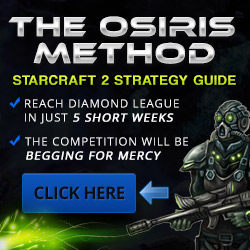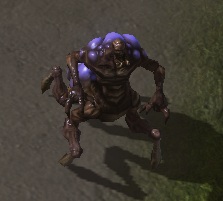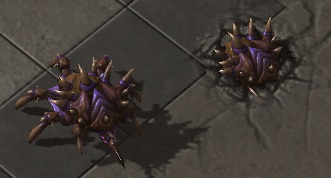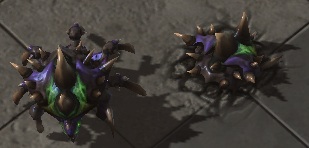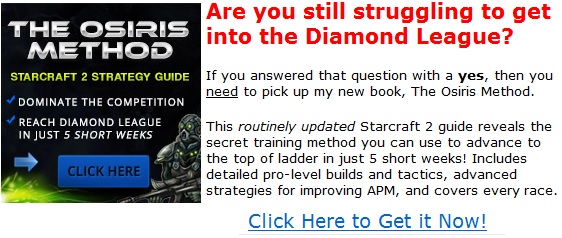Starcraft 2 Heart of the Swarm Campaign Only Units List GuideStarcraft 2 Campaign Guide --> Heart of the Swarm Campaign Guide --> HotS Campaign Units (you are here)
The introduction of these campaign-only units is a very welcome decision by Blizzard as it allowed the developers to introduce a lot of new and unique strategies for players to use in the campaign without ruining the balance of the multiplayer competitive game. It allowed the developers to complete and balance the campaign missions as well before the release of the expansion without the need for an extensive beta test like they used to balance the multiplayer version of Heart of the Swarm. This guide is for the single player campaign-only units, evolutions, and upgrades. It does not go over the new multiplayer units and changes to old multiplayer units. If you are interested in the new units available in competitive play in Heart of the Swarm check out our page on New Units in Heart of the Swarm. If you are interested in how old units, upgrades and structures have changed in competitive play, see our Starcraft 2 Heart of the Swarm Changes Overview. Below, you will find a full list of Zerg units that you can use in the Heart of the Swarm campaign. Since all of the units are slightly different in the campaign versus in the live multiplayer version of the game, every Zerg unit will be listed. For example, the base Zergling in the Heart of the Swarm campaign is the same as the Zergling from the multiplayer version Campaign-only units will be marked with a Campaign Only tag. Quick links to each unit: Zergling Zergling - HotS Campaign UnitStats Before Mutations or Evolutions: Cost: 1 supply, 50 minerals (Zerglings hatch 2 at a time for this cost) Zergling Mutations
Zergling Evolutions
As you might expect, the Zergling is one of the core units in the Zerg army in Heart of the Swarm. The default Zergling is just like the Zergling from the multiplayer version. However, there are no upgrades available at the Spawning Pool in the campaign. Instead, permanent upgrades to the Zergling are available at the Evolution Pit. Swarm Queen - HotS Campaign UnitStats Before Mutations or Evolutions: Cost: 2 supplies, 150 minerals, and 50 vespene gas. Abilities
There are no Swarm Queen mutations or evolutions. In the Heart of the Swarm campaign, Queens are quite different than they are in the live version. First off, they are more expensive, actually costing vespene gas in the campaign. However, they are also much better. Spawn Creep Tumor costs no energy, and creep tumors are better in the campaign than they are in live. Queens do have less health in the campaign (150 versus 175 in live), but they make up for this with their Rapid Transfusion skill. While Transfusion (the live version) and Rapid Transfusion (the campaign version) both restore 2.5 health per energy point spent, Rapid Transfusion will automatically cast and costs less energy, making it useful as an army-wide healing skill. Queens also do bonus damage to armored ground units (an extra 4 DPS) and move much faster off creep than Queens in the multiplayer game. Roach - HotS Campaign UnitStats Before Mutations or Evolutions: Cost: 2 supplies, 75 minerals, 25 vespene gas. Roach Mutations
Roach Evolutions
The Heart of the Swarm campaign Roach is much different than the multiplayer version of the Roach, and possibly not for the better. In the campaign, it has 25 less HP by default and loses access to its movement speed upgrade at the Roach Warren. The evolutions help boost the Roach's strength, but its low HP makes it relatively fragile in the campaign missions. The problem is there are just way too many Siege Tanks and air units for a low HP Roach to be a major part of your army. Baneling - HotS Campaign UnitStats Before Mutations or Evolutions: Cost: 1 Zergling (25 minerals, 1/2 a supply), 25 minerals, 15 vespene gas. Baneling Mutations
Baneling Evolutions
Initially, the Baneling in the Heart of the Swarm campaign functions very similarly to the Baneling in the live version of Starcraft 2. In the end though, the campaign Baneling is much better. The campaign Baneling always moves as fast as if it had the Centrifugal Hooks upgrade. Additionally, the mutations and evolutions significantly improve the strength of the Baneling. Aberration - HotS Campaign Unit - Campaign Only
Stats Before Mutations or Evolutions: Cost: 3 supplies, 200 minerals, 75 vespene gas. There are no Aberration evolutions or mutations. The Aberration is an amazing unit and very underrated. I think a lot of players accidentally overlook this unit because it does not have any evolutions or mutations and is unique to the campaign when in reality this unit is extremely good. One thing that makes this unit so good is that it is the only Zerg unit that will walk over smaller ground units. In other words, both Zerglings and Aberrations can occupy the same spot on the ground and attack the same target. The Aberration can walk right over top of all Zerg ground units except Ultralisks without having to "push" them out of the way. This means that they never get caught in the back in a big fight. For example, if you are using a Hydralisk, Queen and Ultralisk army, it is easy to let your Ultralisks to get stuck behind your Hydralisks and Queens, causing the Ultralisks to not participate in the fight. Abberations on the other hand can walk right over the Hydralisks and join the battle right away. Additionally, the Aberration's stats are just really good. Their 40 base damage to armored (49 with 3 upgrades) is huge, and it lets them shred buildings and heavy Terran fortifications in seconds. 40 damage per swipe is huge on a 3 supply unit. With a 1.2 attack speed, this is a DPS against armored units of 33.33. Compare that to the Ultralisk, which despite costing 6 supplies instead of 3 supplies, has a DPS of 25. Supply for supply, the Aberration does about double the damage of an Ultralisk versus armored units! Hydralisk - HotS Campaign UnitStats Before Mutations or Evolutions: Cost: 2 supplies, 100 minerals, 50 vespene gas. Hydralisk Mutations
Hydralisks Evolutions
The Hydralisk is a balanced unit that can hit both ground and air units from range. It has relatively high DPS for a ranged unit but also has rather low HP. The Ancillary Carapace upgrade improves the Hydralisk's survivability significantly. Lurker - HotS Campaign Unit - Campaign Only
Stats Before Mutations or Evolutions: Cost: 3 supplies (total), 50 minerals, 100 vespene gas, 1 Hydralisk (the Lurker is evolved from
the Hydralisk). There are no Lurker mutation strains available. The Lurker is an evolution of the Hydralisk. The Lurker, like the Impaler, is a high-damage evolution of the Hydralisk that can only attack while burrowed and can only attack ground units. The Lurker is extremely fast and has a moderate range of 6. Its attack does full damage to all units within its rather generous area of effect. The Lurker is fast, but its short range and need to burrow make it a micro-intense unit if used on offense. It is an effective defensive unit. Impaler - HotS Campaign Unit - Campaign Only
Stats Before Mutations or Evolutions: Cost: 3 supplies (total), 1 Hydralisk, 50 minerals, 100 vespene gas. Impalers evolve from
Hydralisks. There are no Impaler mutations strains. The Impaler is an evolution option of the Hydralisk. The Impaler is an excellent unit that can be evolved from the Hydralisk once you complete the Hydralisk evolution mission. While it can only attack while burrowed, it has a long enough range that it can be used on both offense and defense. It does massive amounts of DPS to armored units, particularly given its range. Since buildings count as armored units, it is very effective at attacking enemy structures as well. It is a very cost effective unit as well if microed properly. Mutalisk - HotS Campaign UnitStats Before Mutations or Evolutions: Cost: 2 supplies, 100 minerals, 100 vespene gas. Mutalisk Mutations
Mutalisk Evolutions
The default Mutalisk is a bit weaker in the Heart of the Swarm campaign than it is in the live version of the game. It is a little bit slower in the campaign and does not have its default regeneration that it does in the live version of the multiplayer. It can get regeneration abilities through the mutations, but this regeneration is not as strong as the multiplayer version since it takes 5 seconds to kick in. The redeeming quality of the Mutalisks is that in the first few missions that they are introduced, there is a very limited amount of anti-air units available. With no anti-air around, Mutalisks are naturally very strong. Mutalisks are also good units to use in later missions on defense when you need to defend multiple locations. With the Sundering Glave evolution, the Mutalisk can deal a solid amount of bonus damage to small armored incursions that otherwise can be very devastating, such as a pack of 2-3 Thors and 6 Siege Tanks. On offense, they lose their luster in the later missions, especially versus the Terran computer. Too many Thors, Missile Turrets, and Marines. Brood Lord - HotS Campaign UnitStats Before Mutations or Evolutions: Cost: 4 supplies (total), 150 minerals, 150 vespene gas, 1 Mutalisk (Brood Lords evolve from
Mutalisks) There are no Brood Lord evolution strains. The Brood Lord is an evolution of the Mutalisk. In the campaign, Brood Lords evolve from Mutalisks, as there are no Corruptors in the campaign. Each time a Brood Lord attacks, it spawns 2 Broodlings for free. Broodlings are ground units live for 8 seconds, have 30 HP, have a movement speed of 3.84, have a melee attack of 4 damage and an attack speed of .65. A single Brood Lord can have 6 Broodlings out at once (should the enemy not kill the Broodlings), which can increase its DPS by 36. Broodlings share melee ground and melee carapace upgrades. Brood Lords are in my opinion the strongest unit in the Heart of the Swarm campaign. The computer does not possess the AI to handle Brood Lords effectively and instead prefers to focus down the free Broodlings. Given that 10 Brood Lords can be spawn 20 free Broodlings every 2.5 seconds, it is very easy for a handful of Brood Lords to completely overrun the computer in the campaign without taking any damage. They just need Kerrigan and the Leviathan's support, which can be used to take down any air unit. Viper - HotS Campaign UnitStats Before Mutations or Evolutions: Cost: 3 supplies (total), 100 minerals, 100 vespene gas, 1 Mutalisk (Mutalisks evolve into
Vipers). There are no evolutions or mutations available for the Viper. The Viper is an evolution option of the Mutalisk. There are no Corruptors in the campaign, so Vipers are evolved from Mutalisks. Viper Abilities
Like the Infestor, the Viper in the Heart of the Swarm campaign is significantly stronger than the Viper in the live multiplayer version of the game. First off, the Viper actually has a mild anti-air attack in the campaign, although this does very little damage. More importantly though is the fact that the Viper's abilities are significantly stronger in the campaign versus the live multiplayer version of the game. In the campaign, Abduct only costs 25 energy, whereas in multiplayer it costs 75. In the campaign, Abduct also stuns the abducted unit for 1 second. In multiplayer there is no stun. Disabling Cloud is a better version of Blinding Cloud. While Disabling Cloud lasts 4 seconds less, instead of reducing units to only being able to attack in melee range like Blinding Cloud does, it prevents them from attacking entirely. It also does not effect friendly units. Disabling Cloud also applies a movement speed debuff. It costs 50 energy less than Blinding Cloud. Finally, Consumption is an instant cast that restores energy immediately. It is much better than the Viper's Consume ability in the multiplayer. Ultralisk - HotS Campaign UnitStats Before Mutations or Evolutions: Cost: 6 supplies, 300 minerals, 200 vespene gas. Ultralisk Mutations
Ultralisk Evolutions
The Ultralisk is very strong in the Heart of the Swarm campaign. While its starting DPS is a little lower than in the live multiplayer version of the game, this can be fixed via the Monarch Blades mutation. The Torrasque Strain is ridiculously powerful and is like getting 3 Ultralisks for the price of one over the course of a game. Noxious Strain is not bad either but it gets overshadowed by the strength of Torrasque. Either way players would be well advised to use Ultralisks once you unlock the Evolution mission. Infestor - HotS Campaign UnitStats Before Mutations or Evolutions: Cost: 2 supplies, 100 minerals, 150 vespene gas. There are no evolutions or mutations available for the Infestor in the Heart of the Swarm campaign. HotS Campaign Infestor Abilities
The Infestor is much stronger in the campaign than it is in the live version of the game. While it does not possess the ability to spawn Infested Terrans, the strength of Fungal Growth and Parasitic Domination has improved considerably. Fungal Growth does twice as much damage and is an instant cast, not a projectile like it is in live. Parasitic Domination results in permanent mind control of the targeted unit, whereas Neural Parasite in live is limited by time and range. The Consumption ability ensures that you only need just a few Infestors even if you are constantly casting as they can restore their energy very easily with this skill. Kerrigan or Queens can then heal up any unit damaged by Consumption. The only downside to the Infestor that mitigates its very high power is that it does require micro to use. In the campaign, a lot of your attention to micro will be controlling Kerrigan and possibly the Leviathan, which may make it difficult to use the Infestor in macro-oriented missions. Swarm Host - HotS Campaign UnitStats Before Mutations or Evolutions: Cost: 3 supplies, 200 minerals, and 100 vespene gas. The Swarm Host has no attacks of its own. Instead, it can use the "Spawn Locusts" ability every 15 seconds. This ability spawns 2 Locusts, which are timed ground units that live for up to 12 seconds (less if they are killed before their time runs out). A Locust has these stats by default: Cost: None The Swarm Host's mutations and evolutions can modify either the Swarm Host or the Locus: Swarm Host Mutations
Swarm Host Evolutions
The Swarm Host of the HotS campaign is not nearly as functional as the Swarm Host of the live version of Heart of the Swarm. The campaign version is clearly the "beta" version of this unit that has improved significantly by the time the game finally released. In the campaign, for some reason Locusts do not always automatically generate, meaning that you occasionally have to manually spawn them. They cannot be rallied in the same way as they can in live, making the Swarm Host unit much more micro-intensive than in the campaign. There is also no Enduring Locusts upgrade, so Locusts have a shorter range and lifespan. In the campaign, Swarm Hosts do not have to be detected in order to be seen when "burrowed". Only if you select the Burrow mutation do Swarm Hosts become cloaked while burrowed. However, the Carrion and Creeper strains do significantly improve the strength and value of the Swarm Host. The Carrion strain in particular helps significantly as it boosts the Locust's DPS and allows it to fly, whereas the Pressurized Glands upgrade gives the Locust the ability to hit air units, meaning you can use mass Swarm Host. The only downside to these units is that they require a lot of babysitting and micro, which you have to weigh against spending your time microing Kerrigan. |
Don't be shy - share this page on G+ and Twitter!
Sign up for my Free Starcraft 2 Mini-Course where I reveal my best strategies not seen anywhere on this site!
Starcraft 2 Strategy Guide Privacy Policy Contact Us Disclaimer
©2013 www.osirissc2guide.com
